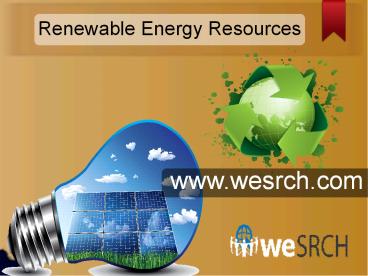Main Form of Renewable Energy Resources - PowerPoint PPT Presentation
Title:
Main Form of Renewable Energy Resources
Description:
Renewable energy is energy which is generated from natural sources i.e. wind, sun, rain etc.what is Renewable energy resources?, How does energy compare to other renewable energy sources? – PowerPoint PPT presentation
Number of Views:742
Title: Main Form of Renewable Energy Resources
1
Renewable Energy Resources
www.wesrch.com
2
Introduction
- Renewable energy is generally defined as energy
that comes from resources which are naturally
replenished on a human timescale such as
sunlight, wind, rain, tides, waves, and
geothermal heat. - Renewable energy resources exist over wide
geographical areas, in contrast to other energy
sources, which are concentrated in a limited
number of countries. Rapid deployment of
renewable energy and energy efficiency is
resulting in significant energy security, climate
change mitigation, and economic benefits - Renewable energy resources and significant
opportunities for energy efficiency exist over
wide geographical areas, in contrast to other
energy sources, which are concentrated in a
limited number of countries.
3
Renewable Energy
Main Form of Renewable Energy
- Wind Energy.
- Hydro Energy.
- Solar Energy.
- Biomass Energy.
- Geothermal Energy.
4
Wind Energy
5
Wind Energy
- Wind is caused by huge convection currents in the
Earth's atmosphere, driven by heat energy from
the Sun. This means as long as the sun shines,
there will be wind. - wind energy is believed to be five times total
current global energy production, or 40 times
current electricity demand. - This could require large amounts of land to be
used for wind turbines, particularly in areas of
higher wind resources. Offshore resources
experience wind speeds of 90 greater than that
of land.
6
Hydro Energy
7
Hydro Energy
- The most common type of hydroelectric power plant
uses a dam on a river to store water in a
reservoir. - Water released from the reservoir flows through a
turbine, spinning it, which in turn activates a
generator to produce electricity. But
hydroelectric power doesn't necessarily require a
large dam. - Hydroelectric energy is a term usually reserved
for large-scale hydroelectric dams. - This includes marine current power, tidal power
and ocean thermal energy conversion.
8
What is Dam
- Dams are massive barriers built across rivers and
streams to confine and utilize the flow of water
for human purposes such as irrigation and
generation of hydroelectricity. - It is a medium to store water at a height.
- Most of hydropower plant rely on dam.
9
Hydro Power Plant
10
Solar Energy
11
Solar Energy
- Solar energy is radiant light and heat from the
sun harnessed using a range of ever-evolving
technologies such as solar heating,
photovoltaics, solar thermal energy, solar
architecture and artificial photosynthesis. - The large magnitude of solar energy available
makes it a highly appealing source of
electricity. - Solar radiation along with secondary solar
resources such as wind and wave power,
hydroelectricity and biomass account for most of
the available renewable energy on Earth. - Passive solar techniques include orienting a
building to the Sun, selecting materials with
favorable thermal mass or light dispersing
properties, and designing spaces that naturally
circulate air.
12
Application of Solar Energy
- Solar lighting.
- water Heating.
- Heating,Cooling Ventilation
- Electrical generation.
13
Biomass Energy
14
Biomass Energy
- Biomass is a renewable energy resource derived
from the carbonaceous waste of various human and
natural activities. It is derived from numerous
sources, including the by-products from the
timber industry, agricultural crops, raw material
from the forest, major parts of household waste
and wood. - Biomass is biological material derived from
living, or recently living organisms. - In the context of biomass for energy this is
often used to mean plant based material, but
biomass can equally apply to both animal and
vegetable derived material. - To many people, the most familiar forms of
renewable energy are the wind and the sun. But
biomass (plant material and animal waste) is the
oldest source of renewable energy, used since our
ancestors learned the secret of fire..
15
Biomass Sources
- Agricultural Crops Residues.
- Sewage.
- Municipal Solid Waste.
- Animals Residues.
- Industrial Residues.
- Forestry Cropes Residues.
16
Geothermal Energy
17
Geothermal Energy
- Geothermal energy is the heat from the Earth.
It's clean and sustainable. - Resources of geothermal energy range from the
shallow ground to hot water and hot rock found a
few miles beneath the Earth's surface, and down
even deeper to the extremely high temperatures of
molten rock called magma. - There is also the potential to generate
geothermal energy from hot dry rocks. - It is the thermal energy contained in the rock
and fluid (that fills the fractures and pores
within the rock) in the earth's crust.
18
www.wesrch.com
energy.wesrch.com































